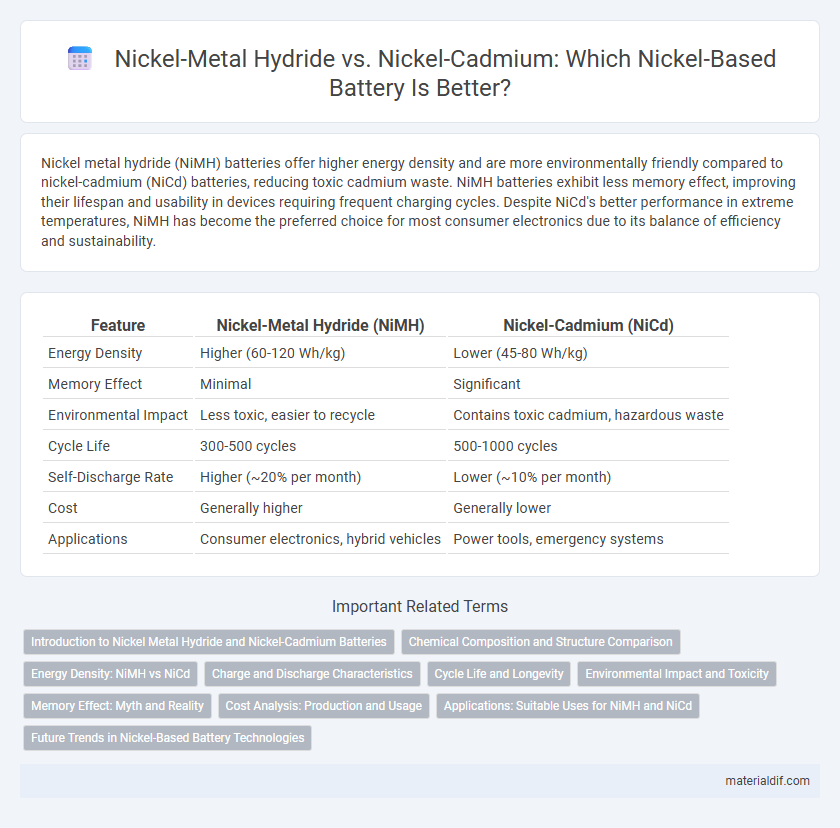Nickel metal hydride (NiMH) batteries offer higher energy density and are more environmentally friendly compared to nickel-cadmium (NiCd) batteries, reducing toxic cadmium waste. NiMH batteries exhibit less memory effect, improving their lifespan and usability in devices requiring frequent charging cycles. Despite NiCd's better performance in extreme temperatures, NiMH has become the preferred choice for most consumer electronics due to its balance of efficiency and sustainability.
Table of Comparison
| Feature | Nickel-Metal Hydride (NiMH) | Nickel-Cadmium (NiCd) |
|---|---|---|
| Energy Density | Higher (60-120 Wh/kg) | Lower (45-80 Wh/kg) |
| Memory Effect | Minimal | Significant |
| Environmental Impact | Less toxic, easier to recycle | Contains toxic cadmium, hazardous waste |
| Cycle Life | 300-500 cycles | 500-1000 cycles |
| Self-Discharge Rate | Higher (~20% per month) | Lower (~10% per month) |
| Cost | Generally higher | Generally lower |
| Applications | Consumer electronics, hybrid vehicles | Power tools, emergency systems |
Introduction to Nickel Metal Hydride and Nickel-Cadmium Batteries
Nickel metal hydride (NiMH) batteries offer higher energy density and reduced environmental impact compared to nickel-cadmium (NiCd) batteries, making them preferable for modern portable electronics. NiCd batteries, containing toxic cadmium, have a robust cycle life and performance in extreme temperatures but pose disposal challenges due to heavy metal content. NiMH chemistry utilizes a hydrogen-absorbing alloy anode, improving energy storage capacity while minimizing memory effect issues associated with NiCd cells.
Chemical Composition and Structure Comparison
Nickel Metal Hydride (NiMH) batteries contain a hydrogen-absorbing alloy as the negative electrode material, replacing the cadmium found in Nickel-Cadmium (NiCd) batteries, which utilize a cadmium metal negative electrode. NiMH cells exhibit a more complex chemical composition with metal hydrides that enable higher capacity and reduced environmental toxicity compared to the simpler cadmium-based structure of NiCd batteries. The crystalline structure of NiMH allows for efficient hydrogen diffusion, enhancing energy density, while NiCd's cadmium-phase structure contributes to superior cycle durability but lower capacity.
Energy Density: NiMH vs NiCd
Nickel Metal Hydride (NiMH) batteries offer significantly higher energy density compared to Nickel-Cadmium (NiCd) batteries, typically ranging from 60 to 120 Wh/kg versus 45 to 80 Wh/kg for NiCd. This higher energy density enables NiMH batteries to store more energy in the same volume, making them more suitable for applications requiring extended runtime and lightweight power sources. Despite their superior energy density, NiMH cells have slightly lower cycle life and can be more sensitive to overcharging than NiCd batteries.
Charge and Discharge Characteristics
Nickel metal hydride (NiMH) batteries exhibit higher charge efficiency and longer charge retention compared to nickel-cadmium (NiCd) batteries, resulting in improved energy density and reduced memory effect. NiMH cells handle higher discharge currents with less voltage drop, making them suitable for high-drain applications, while NiCd batteries show better performance at low temperatures and maintain a more stable voltage output during discharge. The cycle life of NiMH batteries is generally shorter than NiCd, but advancements in electrode materials continue to enhance their charge-discharge durability and overall performance.
Cycle Life and Longevity
Nickel metal hydride (NiMH) batteries offer significantly longer cycle life compared to Nickel-cadmium (NiCd) batteries, often achieving 500 to 1000 charge-discharge cycles versus NiCd's 300 to 500 cycles. NiMH batteries exhibit better longevity due to reduced memory effect and lower toxicity, enhancing their suitability for long-term applications. Improved energy density in NiMH also contributes to sustained performance over extended usage periods compared to NiCd technology.
Environmental Impact and Toxicity
Nickel metal hydride (NiMH) batteries offer a lower environmental impact compared to Nickel-cadmium (NiCd) batteries due to reduced cadmium toxicity, a heavy metal linked to soil and water contamination. NiMH batteries utilize hydrogen-absorbing alloys instead of cadmium, contributing to easier recycling processes and diminished hazardous waste generation. While NiCd batteries pose significant health and environmental risks from cadmium leaching, NiMH cells represent a safer alternative with improved sustainability profiles in energy storage applications.
Memory Effect: Myth and Reality
Nickel-metal hydride (NiMH) batteries exhibit significantly less memory effect compared to nickel-cadmium (NiCd) batteries, making NiMH a more reliable choice for maintaining charge capacity over time. The memory effect in NiCd batteries often results from repeated partial discharge cycles, causing reduced usable capacity, whereas NiMH chemistry mitigates this issue due to its distinct electrode design and chemistry. Research confirms that proper usage and conditioning of NiMH batteries further minimize any potential memory effect, debunking the myth that all nickel-based batteries suffer equally from this phenomenon.
Cost Analysis: Production and Usage
Nickel metal hydride (NiMH) batteries generally have higher initial production costs than nickel-cadmium (NiCd) batteries due to more complex manufacturing processes and materials. However, NiMH batteries offer longer lifecycle and higher energy density, reducing replacement frequency and usage costs over time. NiCd batteries, while cheaper upfront, incur higher environmental disposal costs and suffer from memory effect, impacting long-term economic efficiency.
Applications: Suitable Uses for NiMH and NiCd
Nickel Metal Hydride (NiMH) batteries are widely used in hybrid vehicles, consumer electronics, and cordless power tools due to their higher energy density and environmentally friendly composition compared to Nickel-Cadmium (NiCd). NiCd batteries are preferred in industrial and medical applications where robustness, tolerance to extreme temperatures, and a long cycle life are critical, despite their lower capacity and toxic cadmium content. NiMH batteries suit applications requiring longer run times and reduced memory effect, while NiCd remains optimal for high-drain devices demanding reliable performance under harsh conditions.
Future Trends in Nickel-Based Battery Technologies
Nickel metal hydride (NiMH) batteries continue to outperform nickel-cadmium (NiCd) in energy density and environmental safety, driving their adoption in electric vehicles and portable electronics. Advances in nickel-based battery technologies emphasize enhancing NiMH capacity through improved hydrogen storage alloys and eco-friendly materials, reducing reliance on toxic cadmium. Future trends prioritize sustainable recycling processes and integration of nickel-rich cathodes in hybrid systems, fostering longer lifespan and higher efficiency in energy storage solutions.
Nickel metal hydride vs Nickel-cadmium Infographic

 materialdif.com
materialdif.com